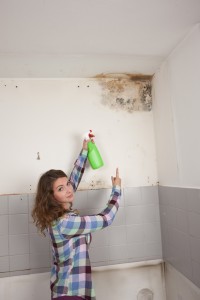Homeowners Insurance And Mold: What Is Covered?

In the majority of cases the mold problem occurs behind the walls or in a place that is difficult to see or access.
The last thing any homeowner wants to hear is that they have mold in their home. It instantly brings to mind terrifying stories of toxic mold poisoning you and your family. Even if the mold proves not to be toxic, you can expect a long, difficult and very expensive cleanup before your house is back to normal and safe to call home.
Mold develops when there is a persistent presence of moisture. In the majority of cases the mold problem occurs behind the walls or in a place that is difficult to see or access. This allows it to thrive and grow into a widespread problem before it is detected. Conditions such as flooding, a leaking roof, high in-house humidity or a leaking appliance are common reasons that mold starts growing.
Unfortunately, there is a good chance that your homeowners insurance is not going to ride to the rescue. Coverage usually depends on the source of the moisture that started the growth. It is always a good idea to read your policy in full and make sure you have a good understanding of your coverage. If the section related to mold is unclear, call your agent.
Am I Covered?
According to experts, the majority of standard homeowners policies do not cover damage to your house that is caused by fungi, bacteria or mold. However, you still may be covered, depending on what started the mold growth in the first place.
If the mold was caused by an accidental and sudden peril that is covered by your policy, the resulting mold issue would also be covered. As an example, if you had a pipe burst and mold was discovered you should be covered, as the reason for the claim was the burst pipe and not the mold. It is also likely that the burst pipe was responsible for the mold.
If it is determined that your mold issue is caused by poor home maintenance, a water leak or seepage that was not promptly repaired or a house that was kept overly humid, the claim would most likely be denied.
If you are unlucky enough to have a mold claim that is denied, be prepared to shell out some serious coin. The Insurance Information Institute found that the average mold claim ranged between $15,000 and $30,000. This was over five times the average claim cost that did not involve mold damage.
As the cost of mold remediation has grown even insurers that do cover mold damage have put a cap on mold payouts. Most policies will limit coverage to between $1,000 and $10,000. Almost all standard policies exclude mold coverage that is caused by flooding.
What Can I Do?
Mold damage caused by flooding will be covered by your flood insurance if you are carrying a separate policy. If you live in a flood prone area it is always a good idea, and your lender will require it if you have a mortgage, to carry a flood insurance policy. While the cost of flood insurance has risen dramatically in the last year, it can be a lifesaver if your home is flooded. A standard homeowners policy offers zero flood protection.
In many cases it is possible to purchase mold coverage. This would come as a rider or add-on to your existing policy. Talk to your agent about your options if you feel that mold damage is a possibility at your house and you are willing to pay for the extra protection.
Costs will vary dramatically depending on your personal risk factors, where you live and the size and value of your home. Budget for anywhere between $500-$1500 a year and if you live in a humid southern state, the costs could be even higher. Older homes tend to be more prone to mold then newer ones.
If your current insurer is unwilling to write a mold rider, there are specialty insurers that will write a stand-alone mold policy but expect the premiums to be sky-high.
Stop Mold in its Tracks
The best way to avoid a costly mold claim is not to get mold in the first place. Here are a few tips on how to keep your house dry and mold free:
- Inspect fittings and hoses on appliances, sinks and toilets on a regular basis.
- Use air conditioners; exhaust fans and dehumidifiers to lower humidity in the house.
- Use primers and paints that are mold resistant.
- Have any leaks, or broken pipes fixed immediately.
- Clean your gutters on regular basis to prevent ice dams and leaks.
If you carpet is flooded or soaked due to a burst pipe, remove the carpet and padding within 48 hours.
